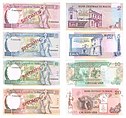Maltese lira
It has been suggested that Maltese pound be merged into this article. (Discuss) Proposed since May 2008. |
| lira Maltija Template:Mt icon | |||||
|---|---|---|---|---|---|
| |||||
| ISO 4217 | |||||
| Code | MTL | ||||
| Unit | |||||
| Plural | liri | ||||
| Symbol | ₤ and Lm | ||||
| Denominations | |||||
| Subunit | |||||
| 1/100 | cent | ||||
| 1/1000 | mil | ||||
| Banknotes | 2, 5, 10, 20 liri | ||||
| Coins | 1, 2, 5, 10, 25, 50 cents, 1 lira | ||||
| Demographics | |||||
| User(s) | |||||
| Issuance | |||||
| Central bank | Central Bank of Malta | ||||
| Website | www.centralbankmalta.com | ||||
| Valuation | |||||
| Inflation | 2.8% | ||||
| Source | The World Factbook, 2006 est. | ||||
| EU Exchange Rate Mechanism (ERM) | |||||
| Since | 2 May 2005 | ||||
| Fixed rate since | 2 May 2005 | ||||
| Replaced by euro, cash | 1 January 2008 | ||||
| 1 € = | 0.429300 liri | ||||
| Band | pegged in practice, 15% de jure | ||||
The lira (Maltese: lira maltija, plural: liri, ISO 4217 code : MTL) was the currency of Malta from 1972 until 31 December 2007. The lira was abbreviated as Lm. In English, the Maltese currency was sometimes referred to as the pound.
The euro replaced the Maltese lira as the official currency of Malta on 1 January 2008 at the irrevocable fixed exchange rate of 0.429300 MTL per 1 euro.
History
Before 1972, the pound circulated, composed of British coins and banknotes supplemented by Maltese notes. Although using British coins, Malta did not decimalize with the UK in 1971. Instead, it adopted a decimal system in 1972, based on the lira (equal to the pound) subdivided into 1000 mils or 100 cents. The name "lira" was used on banknotes beginning in 1973, initially jointly with "pound", and exclusively on both coins and banknotes since 1986. Mils were removed from circulation in 1994.
On entry into the European Union, Malta agreed to adopt the euro. The lira was replaced by the euro on 1 January 2008, as part of the Economic and Monetary Union of the European Union.[1]
Euro changeover
The Maltese lira was replaced by the euro as the official currency of Malta at the irrevocable fixed exchange rate of 0.429300 MTL per 1 EUR. However, Maltese lira banknotes and coins continued to have legal tender status and were accepted for cash payments until 31 January 2008. Maltese liri were convertible free of charge at all Maltese credit institutions until 30 March 2008. Maltese coins were convertible at the Central Bank of Malta until 1 February 2010, and banknotes will be convertible until 31 January 2018.
Coins
Decimal coinage was introduced in 1972 in denominations of 2, 3 and 5 mils, 1, 2, 5, 10 and 50 cents. The division of the lira into 100 cents (rather than the 240 pence of the old system) meant that the cent was a relatively large unit - the United Kingdom introduced the decimal ½ penny for this reason. Malta went "one better" or rather "ten better" in introducing the mil. It will be noted that there was no 1 mil coin. However, the coins that were provided (2, 3, and 5 mils) allowed goods to be priced (and change given) for any number of mils except for one mil. In 1975, a 25 cent coin was introduced.
A new coinage was issued in 1986 in denominations of 1, 2, 5, 10, 25 and 50 cents and 1 lira. A third series was introduced in 1991 due to the change in Malta's coat of arms. The mils were withdrawn in 1994, although for some time only the 5 mils had been seen (and then only rarely).
See also
- Other currencies or coins named lira
- Maltese euro coins
- Highest-valued currency unit
- Economy of Malta
References
External links


